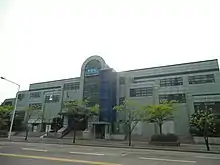Hwamyeong-dong
Hwamyeong is a region in Buk-gu, northern Busan, South Korea. It is situated along the east bank of the Nakdong River, and since 2003 has been divided into three dong, Hwamyeong 1, 2, and 3-dong. The total area of the three dong is approximately 12 km2 (5 sq mi). It was designed to serve as a commuter town for Busan,[1] and was home to about 99,000 people as of February 2020.[2][3][4]
| Hwamyeong-dong | |
| Hangul | 화명동 |
|---|---|
| Hanja | 華明洞 |
| Revised Romanization | Hwamyeong-dong |
| McCune–Reischauer | Hwamyŏng-dong |
Name
There are many different theories regarding the origination of the name Hwamyeong. The most reliable theory is that Mt. Geumjeong, the mountain surrounding Hwamyeong, was once called Mt. Hwa, or Hwasan. This names derives from the mountain being described as an ideal or bright place, and since the Chinese letter for ideal is pronounced 'myeong' in Korean, the name Hwamyeong thus refers to an "ideal bright place."[5] Another theory is that the district's original name was Hwe-Bulgi, which means 'bright sun' or 'red sun'.[2] The literal translation of Hwamyeong, as it is currently spelled, is 'brightly shining,' and is derived from Chinese characters. This name was first attached to the region in 1914, during the period of Japanese rule. At that time, it was known as Hwamyeong-ri, a subdivision of Gupo-myeon. In 1963, it became a dong under the administration of Busanjin-gu. In 1978, it was transferred to Buk-gu, of which it remained a unitary part until its division in 2003.
Transportation
Hwamyeong Station lies on the Gyeongbu Line, and is served by several Mugunghwa-ho and Tonggeun trains daily.
There are two subway station in Hwamyeong-dong, which are named Hwamyeong station(Busan Metro) and Sujeong station(Busan Metro).

Hwamyeong is also served by Busan city bus lines 15, 59, 111, 111-1, 121, 126, 300, and 1009, Yangsan city bus 21, 23, and 23-1, and Busan town shuttle (마을버스) Gyeumjung 1, Bookgu 3, Bookgu 7, and Bookgu 7-2.
Tourism
Hwamyeong ecology park is located near Hwamyeong Station. It has walking trails, baseball parks, soccer fields, tennis courts, basketball courts, an in-line skating rink, and many other amenities for the public to enjoy. At the southern end of the park, there is natural lotus habitat along with an adjacent aqua sports center and outdoor pool, which is open to the public during the Summer.[6]
Hwamyeong arboretum can be found along the banks of the Daechun stream, which traverses Hwamyeong-dong.[7] It has over 200,000 varieties of plants for visitors to observe, and is conveniently located adjacent to the Geumjeongsan hiking trail network.[8] Visitors can look up where certain plants are located using the electronic plant dictionary provided on the website.[9]
The Busan Fishing Village Folk Museum is located right in front of Hwamyeong station. It presents exhibitions detailing the fishing activity of Busan folk villages through the ages, traditional fishing technologies, historic sites, and folklore. The museum also has experiential learning programs for children to help them to understand life before Hwamyeong's rapid development and modernization.[10]
The Hwamyeong Rose Park is right next to the Busan Fishing Village Folk Museum. It is a botanical park divided into 49 sections containing different rose species, and is especially popular during May and June, when the roses are in bloom. A basketball court, a football field, and a multipurpose sports field can also be found within the park.[11]
School
- Hwamyeong highschool
- Korea Communications University
- Myungjin Elementary School
- Yongsu Elementary School
- Geumgok High school
- Geummyeng Middle school
See also
External links
- Hwamyeong 1-dong Office, in Korean
- Hwamyeong 2-dong Office, in Korean
- Hwamyeong 3-dong Office, in Korean
- 지면보기, 입력 2001 07 03 00:00 | 종합 25면 (2001-07-03). "부산 화명동 '새 베드타운' 부상, Pusan Hwamyeon-dong arise as 'New Bed Town'". 중앙일보 (in Korean). Retrieved 2020-03-27.
- "( 동행정복지센터소개 ) | 우리동행정복지센터 | 화명1동 | 동행정복지센터 | 북구 동행정복지센터". www.bsbukgu.go.kr. Retrieved 2020-03-28.
- "( 동행정복지센터소개 ) | 우리동행정복지센터 | 화명2동 | 동행정복지센터 | 북구 동행정복지센터". www.bsbukgu.go.kr. Retrieved 2020-03-28.
- "( 동행정복지센터소개 ) | 우리동행정복지센터 | 화명3동 | 동행정복지센터 | 북구 동행정복지센터". www.bsbukgu.go.kr. Retrieved 2020-03-28.
- "북구향토지 - 지명 유래 - 화명동. Buk-gu land map - name origin - Hwamyeong-dong". library.bsbukgu.go.kr. Retrieved 2020-03-27.
- "생태공원안내 : 부산광역시 낙동강관리본부". www.busan.go.kr. Retrieved 2020-04-02.
- "오시는길 : 부산광역시 화명수목원관리사업소". www.busan.go.kr. Retrieved 2020-04-02.
- "보유식물정보 : 부산광역시 화명수목원관리사업소". www.busan.go.kr. Retrieved 2020-04-02.
- "전자식물도감 : 부산광역시 화명수목원관리사업소". www.busan.go.kr. Retrieved 2020-04-02.
- "어촌민속관 소개 : 부산광역시 해양자연사박물관". www.busan.go.kr. Retrieved 2020-04-02.
- "도심속 정원, 화명 장미공원 만개". tbroad (in Korean). Retrieved 2020-04-03.